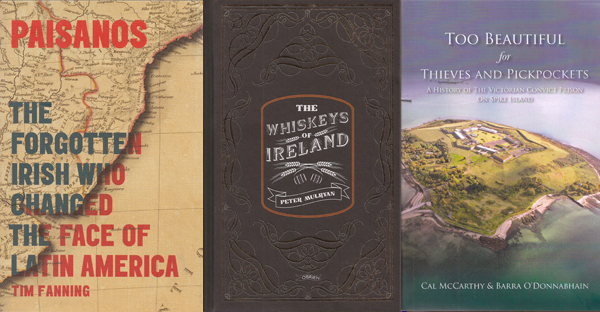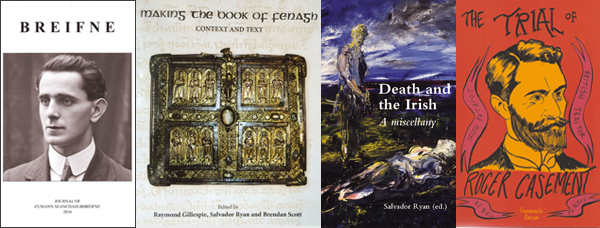BOOKWORM
Published in Book Reviews, Issue 6 (November/December 2016), Reviews, Volume 24By Joe Cully
Maynooth Studies in Local History:
Eamon Darcy, The world of Thomas Ward: sex and scandal in late 17th-century Co. Antrim (Four Courts Press, €9.95 pb, 56pp, ISBN 9781846826092).
Martin McCarthy, The committal of two Mallow children to an industrial school in 1893 (Four Courts Press, €9.95 pb, 62pp, ISBN 9781846826108).
Emmet O’Connor, Derry Labour in the age of agitation: vol 2. Larkinism and syndicalism, 1907–23 (Four Courts Press, €9.95 pb, 68pp, ISBN 9781846826115).
Denis Casey, The Nugents of Westmeath and Queen Elizabeth’s Irish primer (Four Courts Press, €9.95 pb, 60pp, ISBN 9781846826085).
Glascott Symes, Sir John Keane and Cappoquin House in time of war and revolution (Four Courts Press, €9.95 pb, 66pp, ISBN 9781846826139).
Tim Fanning, Paisanos: the forgotten Irish who changed the face of Latin America (Gill Books, €24.99 hb, 256pp, ISBN 9780717171811).
Peter Mulryan, The whiskeys of Ireland (O’Brien Press, €19.99 hb, 192pp, ISBN 9781847177810).
Cal McCarthy and Barra O’Donnabhain, Too beautiful for thieves and pickpockets: a history of the Victorian convict prison on Spike Island (Cork County Library, €13.99 pb, 330pp, ISBN 9780992997014).
Raymond Gillespie, Salvador Ryan and Brendan Scott (eds), Making the book of Fenagh, 1516 (Cumann Seanchais Bhreifne, pb, 180pp, ISSN 0068087765).
Salvador Ryan (ed.), Death and the Irish: a miscellany (Wordwell Books, €25 pb, 300pp, ISBN 9780993351822).
Fionnuala Doran, The trial of Roger Casement (SelfMadeHero, £12.99 pb, 136pp, ISBN 9781910593202).
E.E. O’Donnell, Father Brown’s Titanic album: a passenger’s photographs and personal memoir (Messenger Publications, €19.99 pb, 135pp, ISBN 9781910248270).

Spare a thought for poor old Thomas Ward. In 1694 the then dean of Connor was brought before a royal commission investigating the administration—or alleged lack thereof—within the Church of Ireland diocese of Down and Connor. But Dean Ward faced charges not simply of maladministration but more damningly of adultery. In The world of Thomas Ward: sex and scandal in late 17th-century Co. Antrim, Eamon Darcy uses the reports of Ward’s ‘trial’ to undertake a brief general investigation into the state of the Established Church in east Ulster immediately after the Williamite wars. Not only had the local hierarchy neglected their duties—fiscal, pastoral and moral—for several decades but the church was also under siege from a rapid growth in the number of Presbyterians and a still buoyant Catholic population. The church officials felt that they needed to set a reforming example, and the focus, rightly or wrongly, fell on Dean Ward. Given the era, Ward’s fate rested as much on his reputation as on anything he had actually done. Darcy considers the petty local rivalries, current sexual mores (both those professed and those practised) and broader politics to sketch the time and place. You’ll have to read it to find out how Dean Ward got on.
Darcy’s little treatise—just 56 pages—is one of five new books in the Maynooth Studies in Local History series. The books, according to the editors, address ‘the socially diverse worlds of the poor as well as the rich, women as well as men, children as well as adults and reconstruct the way in which those who inhabited these worlds lived their daily lives, often little affected by the large themes that dominate the writing of national history’. Among them, in a more personal study, Martin McCarthy looks at the story of two of his great-aunts who were committed to an industrial school in Kinsale.
Tim Fanning’s highly enjoyable Paisanos tells the colourful tales of the adventurers, soldiers, merchants and diplomats of Irish lineage whose roles in shaping Latin America are not so much forgotten here as never known in the first place. Most of us are relatively familiar with Admiral Brown and Bernardo O’Higgins. But what, say, of Richard Wall, who became in effect prime minister of Spain? In 1754, at the age of 60, after a childhood at the French court, a career in the Spanish navy and army (including time as a prisoner of the British in Sicily) and then as a diplomat, including ambassador to London, this French-born son of Irish Jacobite refugees was the head of government first for Ferdinand VI and then for his more able brother Charles III. Wall served for nine years. Not surprisingly, Wall was a strong, good-looking, gregarious man ‘who was apt to indulge in the sensual pleasures of the eighteenth-century libertine. He felt equally at home in the company of queens and prostitutes.’ Fanning has an easy prose style and the book is nicely illustrated, with many maps (you can’t have too many maps). As the blurb says, ‘Whether telling the stories of armed revolutionaries … or retracing the steps of trailblazing women like Eliza Lynch and Camila O’Gorman, Paisanos … reanimates the hopes, ambitions, ideals and romanticism that helped fashion the New World and sowed the seeds of Ireland’s revolutions to follow’. Highly recommended.
According to Peter Mulryan, James Joyce was so proud of sharing initials with renowned whiskey magnate John Jameson that he had his wallet engraved ‘JJ’ in the same typeface as the Bow Street distiller. There are a great many similar colourful titbits in The whiskeys of Ireland, Mulryan’s compact but thorough study. Mulryan chronicles the wildly undulating fortunes of the whiskey industry over the centuries (not least the political interference that regularly damaged it), looks at its current renaissance and then gets to the core of the subject: how whiskey is made and what influences the flavour. He clearly loves his subject, and wants you to, too. It’s a handsome hardback from O’Brien Press, and the perfect gift.

A Presbyterian chaplain on Spike Island described the place as ‘Too beautiful for thieves and pickpockets’, the title of Cal McCarthy and Barra O’Donnabhain’s study of the island’s 36-year history as a prison. It began at the height of the Famine, when the established prisons could no longer handle the huge growth in convicts. The early inmates—who helped complete the construction of the prison—were not the worst offenders, and many were awaiting transportation. Not surprisingly, things did not always run smoothly. Many of the early warders were not of the highest calibre. Equally, the mortality rate of the prisoners was at times worryingly high. The authors draw on a trove of official papers to colour in the details.
 Cumann Seanchais Bhreifne/Breifne Historical Society has two new publications: its 2016 journal, Breifne, with topics such as ‘Credible death in Cavan 1641–2’, ‘Marriage settlement of Samual Dundass and Lydia Leadbeater 1827’ and a profile of Dean MacDiarmada; and Making the Book of Fenagh, 1516, a collection of essays on the book’s author and its social and religious context. One of its co-editors, Salvador Ryan, has also been busy editing Death and the Irish, in which you’ll find out about grisly deaths from the Irish annals, the Black Death in Kilkenny, tobacco use at Irish wakes and much more besides. Fionnuala Doran has depicted The trail of Roger Casement in a graphic/comic book form. A third edition of Fr E.E. O’Donnell’s Father Browne’s Titanic album has been released.
Cumann Seanchais Bhreifne/Breifne Historical Society has two new publications: its 2016 journal, Breifne, with topics such as ‘Credible death in Cavan 1641–2’, ‘Marriage settlement of Samual Dundass and Lydia Leadbeater 1827’ and a profile of Dean MacDiarmada; and Making the Book of Fenagh, 1516, a collection of essays on the book’s author and its social and religious context. One of its co-editors, Salvador Ryan, has also been busy editing Death and the Irish, in which you’ll find out about grisly deaths from the Irish annals, the Black Death in Kilkenny, tobacco use at Irish wakes and much more besides. Fionnuala Doran has depicted The trail of Roger Casement in a graphic/comic book form. A third edition of Fr E.E. O’Donnell’s Father Browne’s Titanic album has been released.

















